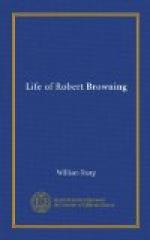Macready, in his Journal,[11] about a week later than the date of his first meeting with the poet, wrote—“Read ‘Paracelsus,’ a work of great daring, starred with poetry of thought, feeling, and diction, but occasionally obscure: the writer can scarcely fail to be a leading spirit of his time.” The tragedian’s house, whither he went at week-ends and on holidays, was at Elstree, a short distance to the northward of Hampstead: and there he invited Browning, among other friends, to come on the last day of December and spend New Year’s Day (1836).[12] When alluding, in after years, to this visit, Browning always spoke of it as one of the red-letter days of his life. It was here he first met Forster, with whom he at once formed what proved to be an enduring friendship; and on this occasion, also, that he was urged by his host to write a poetic play.
[Footnote 11: For many interesting particulars concerning Macready and Browning, and the production of “Strafford,” etc., vide the Reminiscences, vol. i.]
[Footnote 12: It was for Macready’s eldest boy, William Charles, that Browning wrote one of the most widely popular of his poems, “The Pied Piper of Hamelin.” It is said to have been an impromptu performance, and to have been so little valued by the author that he hesitated about its inclusion in “Bells and Pomegranates.” It was inserted at the last moment, in the third number, which was short of “copy.” Some one (anonymous, but whom I take to be Mr. Nettleship) has publicly alluded to his possession of a rival poem (entitled, simply, “Hamelin”) by Robert Browning the elder, and of a letter which he had sent to a friend along with the verses, in which he writes: “Before I knew that Robert had begun the story of the ‘Rats’ I had contemplated a tale on the same subject, and proceeded with it as far as you see, but, on hearing that Robert had a similar one on hand, I desisted.” This must have been in 1842, for it was in that year that the third part of Bells and Pomegranates was published. In 1843, however, he finished it. Browning’s “Pied Piper” has been translated into French, Russian, Italian, and German. The latter (or one German) version is in prose. It was made in 1880, for a special purpose, and occupied the whole of one number of the local paper of Hameln, which is a quaint townlet in Hanover.]




